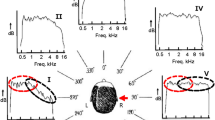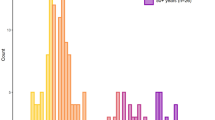Abstract
Several studies have attributed deterioration of sound localization in the horizontal (azimuth) and vertical (elevation) planes to an age-related decline in binaural processing and high-frequency hearing loss (HFHL). The latter might underlie decreased elevation performance of older adults. However, as the pinnae keep growing throughout life, we hypothesized that larger ears might enable older adults to localize sounds in elevation on the basis of lower frequencies, thus (partially) compensating their HFHL. In addition, it is not clear whether sound localization has already matured at a very young age, when the body is still growing, and the binaural and monaural sound-localization cues change accordingly. The present study investigated sound-localization performance of children (7–11 years), young adults (20–34 years), and older adults (63–80 years) under open-loop conditions in the two-dimensional frontal hemifield. We studied the effect of age-related hearing loss and ear size on localization responses to brief broadband sound bursts with different bandwidths. We found similar localization abilities in azimuth for all listeners, including the older adults with HFHL. Sound localization in elevation for the children and young adult listeners with smaller ears improved when stimuli contained frequencies above 7 kHz. Subjects with larger ears could also judge the elevation of sound sources restricted to lower frequency content. Despite increasing ear size, sound localization in elevation deteriorated in older adults with HFHL. We conclude that the binaural localization cues are successfully used well into later stages of life, but that pinna growth cannot compensate the more profound HFHL with age.








Similar content being viewed by others
References
Abel SM, Hay VH (1996) Sound localization. The interaction of aging, hearing loss and hearing protection. Scand Audiol 25:3–12
Abel SM, Giguère C, Consoli A, Papsin BC (2000) The effect of aging on horizontal plane sound localization. J Acoust Soc Am 108:743–752
Agterberg MJ, Snik AF, Hol MK, van Esch TE, Cremers CW, Van Wanrooij MM, Van Opstal AJ (2011) Improved horizontal directional hearing in bone conduction device users with acquired unilateral conductive hearing loss. J Assoc Res Otolaryngol 12:1–11
Algazi VR, Duda RO, Thompson DM, Avendano C (2001) The CIPIC HRTF database. In: IEEE Workshop on Applications of Signal Processing to Audio and Acoustics. New Paltz, New York, pp 99–102
Ashmead DH, Clifton RK, Perris EE (1987) Precision of auditory localization in human infants. Dev Psychol 23:641–647
Batteau DW (1967) The role of the pinna in human sound localization. Proc R Soc Lond B Biol Sci 168:158–180
Blauert J (1997) Spatial hearing. The psychophysics of human sound localization. MIT, Cambridge
Brant LJ, Fozard JL (1990) Age-changes in pure-tone hearing thresholds in a longitudinal-study of normal human aging. J Acoust Soc Am 88:813–820
Bremen P, van Wanrooij MM, van Opstal AJ (2010) Pinna Cues determine orienting response modes to synchronous sounds in elevation. J Neurosci 30:194–204
Burge M, Burger W (1997) Ear biometrics. Springer Int Ser Eng Comput Sci 479:273–285
Cheng CI, Wakefield GH (2001) Introduction to head-related transfer functions (HRTFs): representations of HRTFs in time, frequency, and space. J Audio Eng Soc 49:231–249
Dobreva MS, O’Neill WE, Paige GD (2011) The influence of aging on human sound localization. J Neurophysiol 105:2471–2486
Dobreva MS, O’Neill WE, Paige GD (2012) Influence of age, spatial memory, and ocular fixation on localization of auditory, visual, and bimodal targets by human subjects. Exp Brain Res 223:441–455
Fischer BJ, Pena JL (2011) Owl’s behavior and neural representation predicted by Bayesian inference. Nat Neurosci 14:1061–U1163
Goossens HH, Van Opstal AJ (1997) Human eye-head coordination in two dimensions under different sensorimotor conditions. Exp Brain Res 114:542–560
Heathcote JA (1995) Why do old men have big ears? BMJ:23–30
Hofman PM, Van Opstal AJ (1998) Spectro-temporal factors in two-dimensional human sound localization. J Acoust Soc Am 103:2634–2648
Hofman PM, Van Riswick JGA, Van Opstal AJ (1998) Relearning sound localization with new ears. Nat Neurosci 1:417–421
Kording KP, Wolpert DM (2006) Bayesian decision theory in sensorimotor control. Trends Cogn Sci 10:319–326
Knudsen EI, Konishi M (1979) Mechanisms of sound localization in the barn owl (Tyto alba). J Comp Physiol A 133:13–21
Lopez-Poveda EA, Meddis R (1996) A physical model of sound diffraction and reflections in the human concha. J Acoust Soc Am 100:32–48
Lovett RE, Kitterick PT, Huang S, Summerfield AQ (2012) The developmental trajectory of spatial listening skills in normal-hearing children. J Speech Lang Hear Res 55:865–878
Middlebrooks JC (1992) Narrow-band sound localization related to external ear acoustics. J Acoust Soc Am 92:2607–2624
Middlebrooks JC, Green DM (1991) Sound localization by human listeners. Annu Rev Psychol 42:135–159
Morrongiello BA (1988) Infants localization of sounds along the horizontal axis—estimates of minimum audible angle. Dev Psychol 24:8–13
Niemitz C (2007) Human ears grow throughout the entire lifetime according to complicated and sexually dimorphic patterns—conclusions from a cross-sectional analysis. Anthropol Anz 65:391–413
Noble W, Byrne D, Lepage B (1994) Effects on sound localization of configuration and type of hearing impairment. J Acoust Soc Am 95:992–1005
Rakerd B, Van der Velde TJ, Hartmann WM (1998) Sound localization in the median sagittal plane by listeners with presbyacusis. J Am Acad Audiol 9:466–479
Ross B, Fujioka T, Tremblay KL, Picton TW (2007) Aging in binaural hearing begins in mid-life: evidence from cortical auditory-evoked responses to changes in interaural phase. J Neurosci 27:11172–11178
Schneider BA, Pichora-Fuller MK (2001) Age-related changes in temporal processing: implications for speech perception. Semin Hear 22:227–239
Strouse A, Ashmead DH, Ohde RN, Grantham DW (1998) Temporal processing in the aging auditory system. J Acoust Soc Am 104:2385–2399
Tremblay KL, Piskosz M, Souza P (2003) Effects of age and age-related hearing loss on the neural representation of speech cues. Clin Neurophysiol 114:1332–1343
Van Deun L, Van Wieringen A, Wouters J (2009) Sound localization, Sound lateralization, and binaural masking level differences in young children with normal hearing. Ear Hear 30:178–190
Van Grootel TJ, Van Opstal AJ (2009) Human sound-localization behaviour after multiple changes in eye position. Eur J Neurosci 29:2233–2246
Van Wanrooij MM, Van Opstal AJ (2005) Relearning sound localization with a new ear. J Neurosci 25:5413–5424
Van Wanrooij MM, Van Opstal AJ (2007) Sound localization under perturbed binaural hearing. J Neurophysiol 97:715–726
Yin TC (2002) Neural mechanisms of encoding binaural localization cues in the auditory brainstem. In: Oertel DFR, Popper AN (eds) Integrative functions in the mammalian auditory pathway. Springer, Heidelberg, pp 99–159
Young ED, Davis KA (2002) Circuitry and function of the dorsal cochlear nucleus. In: Oertel DFR, Popper AN (eds) Integrative functions in the mammalian auditory pathway. Springer, Heidelberg, pp 160–206
Zwiers MP, Versnel H, Van Opstal AJ (2004) Involvement of monkey inferior colliculus in spatial hearing. J Neurosci 24:4145–4156
Acknowledgments
We thank H. Kleijnen, P. Bens, T. Arts and M. Verbruggen for their technical support. We thank teachers and children from the primary school Het Talent (Lent, The Netherlands) for their enthusiast cooperation. This research was funded by the William Demants og Hustru Ida Emilies Fond and the Dutch Organization for Scientific Research, through a VICI grant within Earth and Life Sciences of NWO (project grant ALW/VICI 865.05.003; AJVO, MMVW), the Radboud University Nijmegen (AJVO), the Donders Centre for Neuroscience (MJHA), and the Department of Otorhinolaryngology at the Radboud University Medical Centre (AFMS).
Author information
Authors and Affiliations
Corresponding author
Rights and permissions
About this article
Cite this article
Otte, R.J., Agterberg, M.J.H., Van Wanrooij, M.M. et al. Age-related Hearing Loss and Ear Morphology Affect Vertical but not Horizontal Sound-Localization Performance. JARO 14, 261–273 (2013). https://doi.org/10.1007/s10162-012-0367-7
Received:
Accepted:
Published:
Issue Date:
DOI: https://doi.org/10.1007/s10162-012-0367-7




